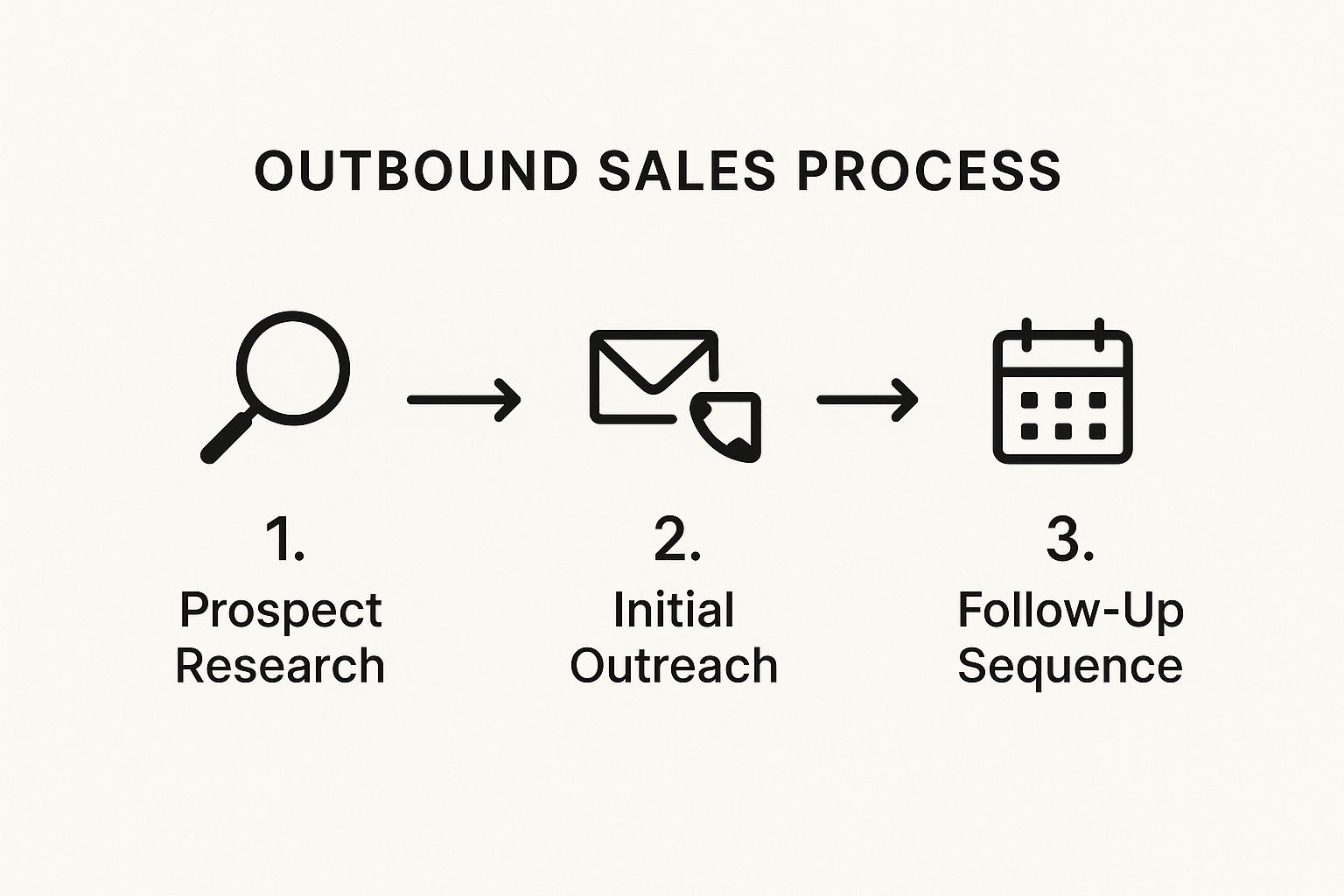Outbound sales is the age-old practice of a company proactively reaching out to potential customers. Instead of waiting for the phone to ring or a web form to be filled out, your sales team is the one making the first move, using channels like cold email, phone calls, and social media.
What Is Outbound Sales in the Modern Business World

To really get what modern outbound sales is all about, stop thinking about random cold calling. Picture your sales team as a group of skilled explorers mapping out new territory. They don't just wander around hoping to stumble upon something; they identify high-value targets and then launch a carefully planned mission to make contact. That's outbound sales today.
It's about seizing control of your sales pipeline. You're not just crossing your fingers, hoping customers find your blog or click on an ad. Instead, you're pinpointing your Ideal Customer Profile (ICP), building lists of prospects who match it, and then systematically reaching out to start a real conversation.
The Myth of the Obsolete Strategy
You've probably heard someone claim that outbound is dead. The truth is, it's more relevant than ever, especially in the B2B world. The strategy hasn't died; it has just evolved. Gone are the days of mindlessly dialing numbers from a phonebook. Today's approach is smart, data-driven, and highly personalized.
Modern outbound sales is less about volume and more about precision. It's the art of delivering the right message to the right person at the right time, creating demand where none existed before.
This proactive approach is incredibly effective. A well-crafted outreach message doesn't get ignored—it grabs the attention of decision-makers. In fact, a staggering 82% of B2B buyers accept meetings from salespeople who initiate contact, proving this is still a massive growth engine. You can dig into more B2B sales insights that back up this approach's power.
Going on the offense gives your business some serious advantages:
- Predictable Pipeline Growth: You control the outreach volume, which means you can create a more predictable flow of leads.
- Targeted Market Penetration: You can strategically break into new markets or go after specific high-value accounts with precision.
- Faster Feedback Loops: Direct chats with prospects give you instant feedback on your messaging, pricing, and product.
To get a clearer picture, this table breaks down the core activities that make up a modern outbound sales motion.
Core Components of Modern Outbound Sales
This is a rundown of the essential activities and objectives that define a smart, contemporary outbound strategy.
| Component | Description | Primary Goal |
|---|---|---|
| Prospect Research | Identifying and gathering data on companies and contacts that fit your Ideal Customer Profile (ICP). | Build a highly targeted list of qualified potential buyers. |
| Initial Outreach | The first point of contact, typically via personalized email, a targeted social message, or a well-researched call. | Capture attention, provide value, and start a conversation. |
| Follow-Up Sequence | A series of planned, multi-channel touchpoints over a set period to stay top-of-mind and nurture interest. | Secure a meeting or a concrete next step in the sales process. |
| Qualification | The process of asking targeted questions to determine if the prospect has a genuine need and is a good fit for your solution. | Ensure time is spent only on leads with a high probability of closing. |
Each of these stages builds on the last, turning a cold start into a warm opportunity. When done right, it's one of the most powerful ways to build a scalable sales machine.
Outbound vs Inbound Sales: Pushing vs Pulling

To really get what outbound sales is all about, it helps to put it side-by-side with its more famous counterpart, inbound sales. The simplest way to think about it is "push vs. pull."
Outbound sales is a push strategy. You're actively pushing your message out to a specific audience, creating awareness and drumming up new demand where it might not have existed before.
Inbound, on the other hand, is a pull strategy. This is where you create great content, nail your website's SEO, and build a brand that naturally pulls in people who are already looking for what you offer. They find you.
This single difference shapes everything, from how you first make contact to how much your prospect already knows about their own problems.
Methodologies and Mindsets
With outbound, you're on the offensive. Your sales team is the one starting the relationship, often with people who don't even realize they have a problem you can fix. It's like knocking on a potential client's door to introduce a new service that could save them a ton of money. They weren't looking, but you created the opportunity.
Inbound is reactive. The business sets up "magnets"—think blog posts, webinars, or free tools. A prospect stumbles upon these resources on their own and makes the first move. This means they're already "problem-aware" and hunting for answers, which makes for a much warmer first conversation.
The core distinction is who starts the conversation. Outbound is about creating opportunities from scratch. Inbound is about capturing opportunities from people who are already looking.
The Perception Gap and Strategic Use
While inbound gets all the love for delivering high-intent leads, relying on it alone means you're only growing as fast as people can find you. Outbound lets you surgically target and break into new markets.
But let's be honest, outbound has a bit of a reputation problem. One analysis found that only 16% of marketers believe outbound strategies bring in high-quality leads. Worse, over half (52%) think their efforts are flat-out ineffective. You can dig into more of these stats by checking out the current state of outbound sales on nethunt.com.
This data tells a crucial story: bad, spammy outbound doesn't work. But smart, strategic outbound is an absolute powerhouse for growth. It’s never about one being better than the other; a truly solid sales strategy needs both.
- Use Outbound When: You're launching in a new market, going after high-value enterprise clients, or need fast feedback on a new product.
- Use Inbound When: You want to build a brand for the long haul, create a steady flow of leads over time, and position your company as an industry expert.
Ultimately, outbound pushes your reach beyond its current limits, while inbound pulls in and nurtures the audience you've already built. Together, they create a complete system for real, sustainable growth.
Building Your Outbound Sales Playbook Step by Step
A powerful outbound sales program doesn’t just happen. It’s a structured, repeatable system—a playbook that guides every single action your team takes. When you build this playbook, you transform your outreach from a wild guessing game into a predictable engine for new opportunities.
The whole process kicks off long before you even think about sending that first email. The real foundation of any killer outbound strategy is a crystal-clear understanding of who you're trying to reach. This is your Ideal Customer Profile (ICP).
Step 1: Define Your Ideal Customer Profile
Your ICP is a hyper-detailed description of the perfect company for your product or service. This isn't just about broad strokes like industry and company size; it’s about the nitty-gritty details that signal a fantastic fit. Think about things like their current tech stack, the size of their team, any recent funding rounds, or specific business challenges they’re wrestling with.
Without a sharp ICP, your outreach is just shouting into the void. But with one, you can laser-focus all your energy on accounts that have the highest possible chance of becoming happy, long-term customers. A solid ICP makes every other step that follows way more effective.
Step 2: Build a High-Quality Prospect List
Once you know the type of company you're after, the next move is to find the actual companies and, more importantly, the right people inside them. This is where prospect list building comes in. Your mission here is to create a clean, accurate, and super-targeted list of contacts that perfectly match your ICP.
This stage is absolutely critical. A list riddled with outdated info or the wrong contacts will sink your campaign before it even sets sail. Always focus on quality over quantity. It's so much better to have a list of 100 perfect-fit prospects than 1,000 who are just "meh." You can dive deeper into this with our guide to modern outbound lead generation.
Step 3: Craft Your Outreach Cadence
Okay, now it’s time to plan your communication. A sales cadence is simply a scheduled sequence of touchpoints across different channels—like email, phone calls, and social media—all designed to engage a prospect over a set period. One email almost never cuts it. Persistence is key.
This infographic breaks down the core flow of an outbound process pretty well.

As you can see, it highlights how structured stages—from research to outreach and follow-up—work together to move a prospect along. Each step is a deliberate action, not a random shot in the dark.
For instance, a simple cadence might look something like this:
- Day 1: Personalized Email #1
- Day 3: LinkedIn Connection Request
- Day 5: Follow-up Email #2 (as a reply to the first)
- Day 7: Phone Call
- Day 10: Final Follow-up Email
The idea is to be persistent without being a pest, adding a bit of value at each touchpoint.
Step 4: Execute and Qualify
With your playbook built and ready to go, it’s showtime. Launch your campaigns and track the results like a hawk. As the replies start trickling in, your focus shifts immediately to qualification.
Qualification is the art of figuring out if a prospect has a real, pressing need that your solution can actually solve. It’s about separating the curious onlookers from the genuinely committed buyers.
This means asking smart questions to get a handle on their pain points, budget, authority, and timeline (a classic framework known as BANT). Nailing your qualification process ensures your sales team spends its precious time only on opportunities that have a real shot at closing. That makes the entire outbound machine more efficient and, ultimately, more profitable.
Effective Outbound Strategies That Actually Work

Having a solid playbook is a great start, but a slick process only gets you to the starting line. To actually win in outbound sales, you need to shift from process to performance. It’s all about using strategies that genuinely grab attention and start building real relationships.
This means being thoughtful, persistent, and showing up across different channels. The campaigns that really crush it are built on three pillars: deep personalization, a multi-channel approach, and relentless follow-up. Get these right, and your outreach transforms from just another email into a welcome conversation.
Personalization That Goes Beyond a Name
Let's be clear: true personalization isn't just dropping a {FirstName} tag into your email template. It’s about proving you’ve done your homework and actually understand your prospect’s world. This is what separates meaningful outreach from what is essentially just sophisticated spam.
Think about the difference between these two attempts:
- Generic: "Hi John, I saw you're the VP of Sales at Acme Corp. I’d love to show you how our tool can help your team."
- Personalized: "Hi John, I saw your post on LinkedIn about the challenges of ramping up new SDRs. We helped a similar company in your space cut their ramp time by 30% with a targeted coaching framework."
See the difference? The second example is immediately relevant and builds instant credibility. This is the kind of detail that earns a response. For more practical tips on digging up these valuable details, check out our guide on prospecting on LinkedIn.
Orchestrating a Multi-Channel Cadence
Relying on a single channel like email is a surefire way to get ignored. Your prospects are busy people, drowning in hundreds of messages every single day. A modern outbound strategy coordinates touchpoints across different platforms—like email, LinkedIn, and phone calls—to create a unified experience.
A well-planned cadence isn't about bombarding someone. It’s about creating multiple, logical opportunities to connect in the channel they actually prefer. It shows you’re serious about starting a real dialogue. Understanding the little nuances in your customer interactions is key here. To sharpen your phone game, you can explore some great sales call insights to close more deals.
A multi-channel strategy recognizes that your prospect's attention is fragmented. By showing up in multiple relevant places, you're not just sending a message; you're building a presence.
The Power of Persistent Follow-Up
Giving up too early is one of the most common—and most expensive—mistakes you can make in outbound sales. The hard truth is that most deals require a good bit of persistence just to get a foot in the door.
The research here is stunning: 80% of sales require five or more follow-up interactions. Yet, an incredible 44% of salespeople throw in the towel after just one attempt. That’s a massive gap between effort and results.
Building a cadence with at least five to seven touchpoints isn't just a good idea anymore; it's the new standard for anyone who wants to succeed.
How Technology Is Changing the Outbound Sales Game
Not too long ago, outbound sales was a high-effort guessing game. Today, technology has flipped the script, turning it into a much more precise, data-backed discipline. The right tools act like a "sales co-pilot," taking over the most tedious parts of the job so your team can focus on what they do best: building real rapport and closing deals.
Think about the old way of doing things—endless hours spent digging for leads, manually updating records, and trying to keep track of every conversation. Modern platforms handle all that grunt work, giving your team a massive efficiency boost. This shift doesn’t replace skilled salespeople; it makes them even better by letting them zero in on high-value conversations instead of low-value admin.
Giving Sales Reps Superpowers with Automation
Automation is all about tackling the repetitive tasks that drain a salesperson's energy and time. Instead of spending an entire morning trying to build a decent list, a rep can now generate hundreds of qualified prospects in just a few minutes. This is a fundamental change, shifting the focus from manual labor to smart, strategic execution.
For example, a platform like Salesloop.io can run your prospecting and outreach on autopilot. Your team simply defines its ideal customer, builds a target list, and launches a multi-step email sequence that works behind the scenes.
The screenshot above shows just how easy it is to build a highly targeted prospect list right inside the platform. What used to be a mind-numbing task now takes just a few clicks. This frees up your reps to actually prepare for meetings and craft truly personal follow-ups for their hottest leads.
This "work smarter, not harder" approach is catching on fast. In fact, a whopping 61% of organizations are planning to increase their spending on sales tech. It’s a clear sign that business leaders understand that better tools drive better results.
The Rise of the Data-Driven Sales Team
But technology’s impact goes way beyond just automating tasks. Modern tools give sales leaders deep analytical insights that were simply out of reach before. Now, you can track every single part of your outbound engine with incredible precision.
Technology transforms outbound from an art based on intuition to a science based on data. It provides the visibility needed to diagnose problems, replicate success, and build a truly predictable revenue machine.
Here are a few ways technology is reshaping the field:
- Data Enrichment: Tools can automatically track down missing contact info, company details, and even social media profiles. This gives reps the context they need to stop sounding generic and start having meaningful conversations.
- Intelligent Sequencing: Smart platforms can adjust outreach based on a prospect's behavior, like opening an email or clicking a link. This ensures every follow-up is timely and relevant, not just another "just checking in" email.
- Performance Analytics: Detailed dashboards show you exactly which messages, subject lines, and cadences are actually working, allowing you to double down on what’s effective and ditch what isn’t.
To really get your outbound engine firing on all cylinders, having the right tech stack is non-negotiable. You can explore a breakdown of the 8 best sales apps for boosting revenue to see what might fit your strategy. At the end of the day, technology gives your team the power to be more targeted, efficient, and successful than ever before.
If you can't measure it, you can't improve it. This old saying is the gospel for outbound sales.
Running an outbound program without tracking performance is like flying a plane with no instruments. Sure, you’re moving, but you have no idea if you’re actually heading in the right direction. This is where we stop focusing on just being busy and start focusing on being effective.
To do that, you need a clear dashboard of key performance indicators (KPIs). These are the numbers that tell you what’s working, what’s broken, and where to focus your energy. It’s time to move past vanity metrics like email open rates and build a truly predictable growth engine.
Core Metrics That Directly Impact Your Bottom Line
Think of your outbound strategy as a finely tuned machine. Certain metrics are the gauges that show you the health of each moving part. By keeping a close eye on them, you can spot trouble early and make adjustments based on real data, not just guesswork.
Here are the essential KPIs you absolutely have to be tracking:
- Positive Reply Rate: This isn't just any reply; it’s the percentage of prospects who respond with genuine interest (not an "out of office" auto-reply). This number is a direct reflection of your messaging quality and targeting accuracy. If it's low, your value proposition probably isn't hitting the mark.
- Meetings Booked: For most campaigns, this is the whole point of the initial outreach. This metric tells you if your hard work is successfully turning interest into actual sales conversations—a critical step in filling your pipeline.
- Pipeline Generated: This measures the total potential dollar value of the opportunities created by your outbound efforts. It’s a powerful way to show the direct financial impact your team's work is having on the company’s future revenue.
Optimizing Your Process for a Stronger ROI
Once you start tracking these numbers, the real fun begins: optimization.
A low positive reply rate, for example, is a huge red flag that your messaging needs a tune-up. If that's the case, you can explore our guide for ideas on how to personalize your sales outreach at scale to make your communication more impactful.
The key is to constantly test different subject lines, call scripts, and value propositions. You'd be surprised how small, deliberate tweaks can lead to massive improvements over time.
The goal isn't just to gather data; it's to use that data to make smarter decisions. An optimized outbound process is one that is constantly learning and adapting based on real-world feedback from your target market.
This commitment to refinement pays off, big time. Investing in outbound sales training and process optimization yields a remarkable return, with some companies reporting up to 353% ROI and a 50% increase in sales per representative. To see more on this, learn more about these outbound sales findings. It’s definitive proof of the link between fine-tuning your engine and driving better financial results.
Frequently Asked Questions About Outbound Sales
As you start to map out what outbound sales could look like for your business, a few common questions always seem to surface. Getting straight answers is the first step to building a strategy you can actually feel good about. Let's tackle some of the biggest ones I hear all the time.
Is Cold Calling Still Effective?
Yes, but it looks completely different now. The days of randomly dialing down a list are over—thankfully. But a strategic, well-researched call to the right person is still one of the most powerful tools in sales, especially for high-value B2B deals.
Think of a modern "cold" call as just one piece of a bigger puzzle, a single touchpoint in a campaign that might also include emails and LinkedIn messages. The goal usually isn't to make a sale on the spot. It's to start a real conversation, see if there's a spark of interest, or book a proper meeting. For cutting through the noise and reaching a busy decision-maker, nothing beats a well-timed phone call.
How Long Until I See Results From Outbound?
This is where patience and consistency become your best friends. While you can see early signs of life—like email opens and a few positive replies—within the first couple of weeks, building a predictable pipeline of meetings takes time.
You should expect to see consistent meetings being booked within 1-3 months. A more substantial impact on revenue often takes 3-6 months as you gather data, refine your messaging, and perfect your targeting.
It’s more like planting seeds than flipping a switch. The exact timeline really depends on your industry's sales cycle, how complex your deals are, and frankly, how well you execute the plan.
Can a Small Business Succeed With Outbound Sales?
Absolutely. In fact, for a small business that doesn't have a big brand name pulling in leads, outbound can be a total game-changer. The secret isn't trying to out-muscle the big guys with sheer volume. It’s all about surgical precision.
A small business can get incredible results by zeroing in on a very specific Ideal Customer Profile (ICP) where they have a clear, undeniable advantage. With today's affordable automation and data tools, a single person can run an outbound program that punches way above its weight and becomes a serious engine for growth.
Ready to stop guessing and start growing? Salesloop.io gives you the tools to build a predictable outbound sales engine with less effort. Automate your outreach, find the perfect prospects, and fill your calendar with qualified meetings. Start your journey with Salesloop.io today.





